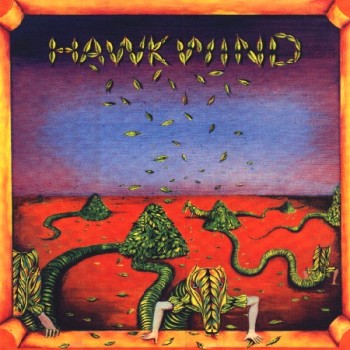Other fans
might argue with me, but the Hawkwind record I’d choose for inclusion on the
interstellar comp would be In Search of
Space. It’s their second album, released in 1971, and the first where they
fully embraced the sci-fi aesthetic. When the aliens figure out how to play the
golden record with the diamond stylus that comes with it, they’ll hear familiar
cosmic sounds: the light ticking of radar signals, blobular pulsations like
those from a vast cloud of cosmic dust, the built up pressure of pent-up
nuclear energy, a metronomic countdown and then, blast off! Their ears will be
rocketing though space like intergalactic bandits on a star-faring hot rod. In
earthly terms, the opening track, a 15+ minute epic called “You Shouldn’t Do
That,” has an early heavy metal/proto-punk feel -- a couple of chords played
fast and hard, but all throughout are strange oscillations and vibrations of
space tones, like the sound effects from movies where little green men shoot
laser beams and photon waves. And all these sounds weave and meld together into
a singular force of forward momentum that’ll likely please the ears and minds
of whatever ultra-intelligent beings happen to find them.
I’d caution
against including Hawkwind’s third album, though. Upon listening to the 1972
release Doremi Faso Latido, they
might think we mean them harm. The punk and heavy metal elements are more
pronounced here, so it’s much darker, more sinister (though the flying saucer
sounds remain). To my ears, it’s like the soundtrack of an interstellar warlord
civilization on a mission to conquer the universe. The vocals remind me a bit
of Ozzy—high-pitched but flat, and shouted. The heavy guitar riffs pulsate and
drone like a lot of metal and hardcore, but there’s enough variance across both
sides of the album—a bit of acoustic guitar and saxophone and some shifts in
syncopation—to keep it from feeling monotonous and redundant. In fact, there’s
so much going on in the music, between the pulse and drive of the songs and the
weird noises that float around it, that it starts to form aural moirés that are
so intense they set your head to spinning. Fun for a wild night on earth, to be
sure, but probably not appropriate as a greeting to fellow space beings.
I
definitely do not recommend sending Hawkwind’s first self-titled record, though
in some respects it’s my favorite. I vote against it only because it reveals
the band in their pre-space days, when they were more of an acid rock group.
Pondering the heavens, to be sure, but still lacking the wherewithal to fully
escape the earth. The opening track, “Hurry On Sundown,” has a bluesy/folksy
feel. It begins with a bright riff strummed on an acoustic guitar, then a
blaring harmonica kicks in and dances along with the melodic vocals. On the
second track, they venture a fair distance into space, but it’s a
feedback-based approximation of space that’s still rooted in earthliness.
There’s less artifice; you can picture ragamuffin stoners making the music in
some groovy pad somewhere, tripping out. The shape of some of the songs is less
streamlined and symmetrical than on their later records, too. The third track,
“Be Yourself,” for instance, has an odd three-beat form that’s kind of arty in
a punk-rock sort of way, the punkiness due mainly to shouted lyrics. Side two
has a similar form, only in reverse, going from off-centered, dark melody and
rhythm, through several interludes of guitar-and-amp cosmos (with a touch of
crazy saxophone from the gates of hell thrown in), and it ends with another
down-to-earth tune, “Mirror of Illusion,” which verges on pop, in a hippy sort
of way. It’s a great album, but probably not the best hello for whoever might
be out there, millions of light years away. Better to wait to play the space
creatures Hawkwind’s first record when they finally arrive at our home planet, where
we can have them over for supper and wine and maybe even some of our precious
herbs for a long night gathered around a real turntable.




No comments:
Post a Comment